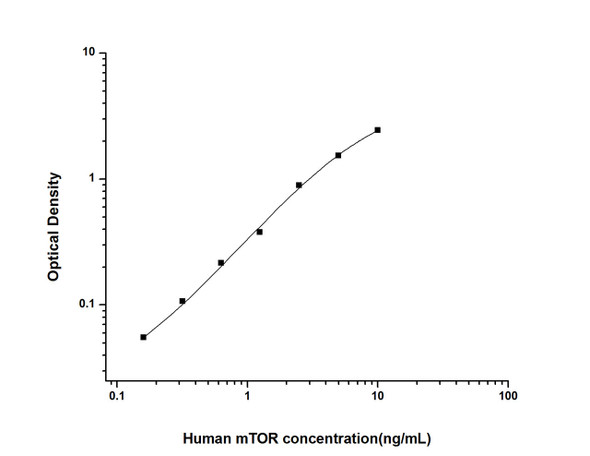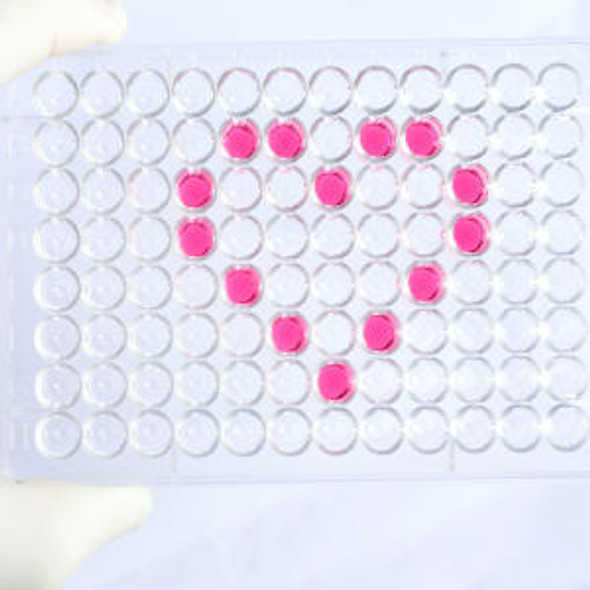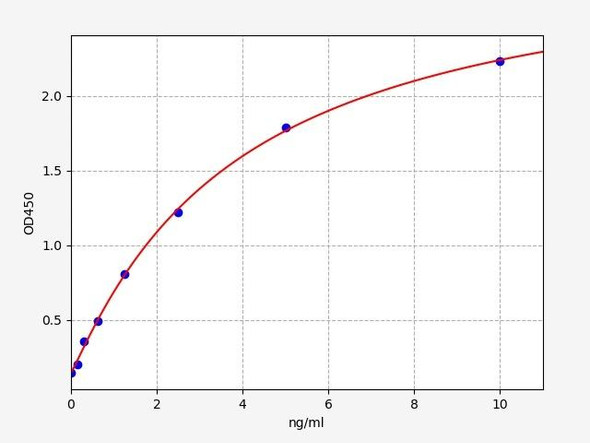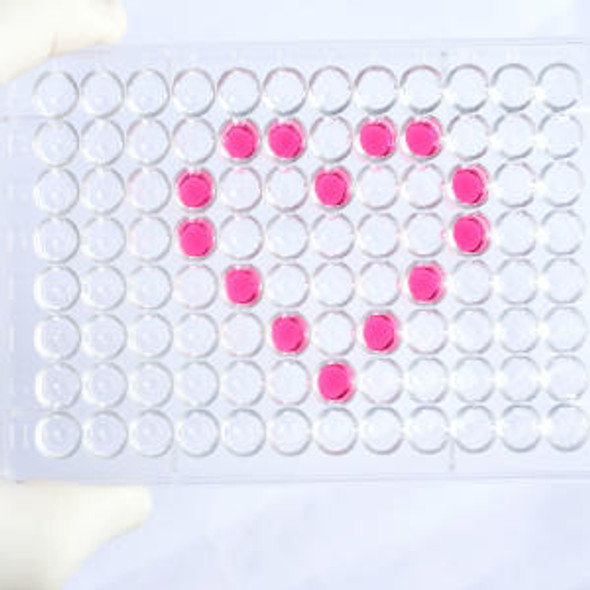Human Cell Biology ELISA Kits 5
Human mTOR (Mammalian Target of Rapamycin) CLIA Kit (HUES00931)
- SKU:
- HUES00931
- Product Type:
- ELISA Kit
- ELISA Type:
- CLIA Kit
- Size:
- 96 Assays
- Sensitivity:
- 18.75pg/mL
- Range:
- 31.25-2000pg/mL
- ELISA Type:
- Sandwich
- Synonyms:
- FRAP1, RAFT1, RAPT1, Mechanistic target of rapamycin, FK506 binding protein 12-rapamycin associated protein 1
- Reactivity:
- Human
- Sample Type:
- Serum, plasma and other biological fluids
- Research Area:
- Cell Biology
Description
| Assay type: | Sandwich |
| Format: | 96T |
| Assay time: | 4.5h |
| Reactivity: | Human |
| Detection method: | Chemiluminescence |
| Detection range: | 31.25-2000 pg/mL |
| Sensitivity: | 18.75 pg/mL |
| Sample volume: | 100µL |
| Sample type: | Serum, plasma and other biological fluids |
| Repeatability: | CV < 15% |
| Specificity: | This kit recognizes Human mTOR in samples. No significant cross-reactivity or interference between Human mTOR and analogues was observed. |
This kit uses Sandwich-CLIA as the method. The micro CLIA plate provided in this kit has been pre-coated with an antibody specific to Human mTOR. Standards or samples are added to the appropriate micro CLIA plate wells and combined with the specific antibody. Then a biotinylated detection antibody specific for Human mTOR and Avidin-Horseradish Peroxidase (HRP) conjugate are added to each micro plate well successively and incubated. Free components are washed away. The substrate solution is added to each well. Only those wells that contain Human mTOR, biotinylated detection antibody and Avidin-HRP conjugate will appear fluorescence. The Relative light unit (RLU) value is measured spectrophotometrically by the Chemiluminescence immunoassay analyzer. The RLU value is positively associated with the concentration of Human mTOR. The concentration of Human mTOR in the samples can be calculated by comparing the RLU of the samples to the standard curve.
| UniProt Protein Function: | mTOR: an atypical kinase belonging to the PIKK family of kinases. Is the catalytic subunit of two protein complexes, mTORC1 and mTORC2. mTORC1 activates S6K and inactivates 4E-BP1, up-regulating protein synthesis. mTORC1 contains Raptor, a positive regulatory subunit and scaffold for recruiting substrates, two negative regulators, PRAS40 and DEPTOR, and mLST8; it is a target for the cell-cycle arrest and immunosuppressive effects of the FKBP12-rapamycin complex. mTORC2, a downstream effector of PI3K, is insensitive to rapamycin and activates Akt by phosphorylating a key activation site. mTORC2 contains regulatory subunits Rictor and mSIN1, PROTOR, mLST8, and the negative regulator DEPTOR. mTORC1 suppresses PI3K activity via a strong negative feedback loop that involves S6K1. Inhibiting mTORC1 ablates this negative feedback loop and potentiates PI3K signaling. Known inhibitors of mTOR include rapamycin, temsirolimus (CCI-779). |
| UniProt Protein Details: | Protein type:Protein kinase, atypical; Motility/polarity/chemotaxis; Protein kinase, Ser/Thr (non-receptor); Autophagy; EC 2. 7. 11. 1; Kinase, protein; ATYPICAL group; PIKK family; FRAP subfamily Chromosomal Location of Human Ortholog: 1p36. 2 Cellular Component: cell soma; cytoplasm; cytosol; dendrite; endomembrane system; endoplasmic reticulum membrane; Golgi membrane; lysosomal membrane; lysosome; membrane; mitochondrial outer membrane; nucleoplasm; phosphoinositide 3-kinase complex; PML body; TORC2 complex Molecular Function:ATP binding; drug binding; kinase activity; phosphoprotein binding; protein binding; protein domain specific binding; protein kinase binding; protein serine/threonine kinase activity; ribosome binding Biological Process: 'de novo' pyrimidine base biosynthetic process; brain development; cardiac muscle cell development; cardiac muscle contraction; cell aging; cell cycle arrest; cell growth; cellular response to nutrient levels; DNA repair; energy reserve metabolic process; epidermal growth factor receptor signaling pathway; fibroblast growth factor receptor signaling pathway; gene expression; germ cell development; growth; heart morphogenesis; innate immune response; insulin receptor signaling pathway; long-term memory; macroautophagy; maternal process involved in pregnancy; mRNA stabilization; multicellular organism growth; negative regulation of autophagy; negative regulation of cell size; negative regulation of muscle atrophy; negative regulation of NFAT protein import into nucleus; negative regulation of protein amino acid phosphorylation; negative regulation of protein ubiquitination; nerve growth factor receptor signaling pathway; peptidyl-serine phosphorylation; peptidyl-threonine phosphorylation; phosphoinositide-mediated signaling; phosphorylation; positive regulation of actin filament polymerization; positive regulation of endothelial cell proliferation; positive regulation of lipid biosynthetic process; positive regulation of neuron maturation; positive regulation of nitric oxide biosynthetic process; positive regulation of oligodendrocyte differentiation; positive regulation of peptidyl-tyrosine phosphorylation; positive regulation of protein amino acid phosphorylation; positive regulation of protein kinase B signaling cascade; positive regulation of smooth muscle cell proliferation; positive regulation of stress fiber formation; positive regulation of transcription from RNA polymerase III promoter; positive regulation of translation; post-embryonic development; protein amino acid autophosphorylation; protein amino acid phosphorylation; protein catabolic process; regulation of actin cytoskeleton organization and biogenesis; regulation of carbohydrate utilization; regulation of fatty acid beta-oxidation; regulation of glycogen biosynthetic process; regulation of GTPase activity; regulation of myelination; regulation of osteoclast differentiation; regulation of protein kinase activity; regulation of response to food; response to amino acid stimulus; response to cocaine; response to morphine; response to nutrient; response to stress; ruffle organization and biogenesis; signal transduction; social behavior; spinal cord development; T cell costimulation; TOR signaling pathway; transcription initiation from RNA polymerase II promoter; vascular endothelial growth factor receptor signaling pathway; visual learning; voluntary musculoskeletal movement; wound healing |
| NCBI Summary: | The protein encoded by this gene belongs to a family of phosphatidylinositol kinase-related kinases. These kinases mediate cellular responses to stresses such as DNA damage and nutrient deprivation. This protein acts as the target for the cell-cycle arrest and immunosuppressive effects of the FKBP12-rapamycin complex. The ANGPTL7 gene is located in an intron of this gene. [provided by RefSeq, Sep 2008] |
| UniProt Code: | P42345 |
| NCBI GenInfo Identifier: | 1169735 |
| NCBI Gene ID: | 2475 |
| NCBI Accession: | P42345. 1 |
| UniProt Secondary Accession: | P42345,Q4LE76, Q5TER1, Q6LE87, Q96QG3, Q9Y4I3, |
| UniProt Related Accession: | P42345 |
| Molecular Weight: | 288,892 Da |
| NCBI Full Name: | Serine/threonine-protein kinase mTOR |
| NCBI Synonym Full Names: | mechanistic target of rapamycin |
| NCBI Official Symbol: | MTOR |
| NCBI Official Synonym Symbols: | SKS; FRAP; FRAP1; FRAP2; RAFT1; RAPT1 |
| NCBI Protein Information: | serine/threonine-protein kinase mTOR |
| UniProt Protein Name: | Serine/threonine-protein kinase mTOR |
| UniProt Synonym Protein Names: | FK506-binding protein 12-rapamycin complex-associated protein 1; FKBP12-rapamycin complex-associated protein; Mammalian target of rapamycin; mTOR; Mechanistic target of rapamycin; Rapamycin and FKBP12 target 1; Rapamycin target protein 1 |
| Protein Family: | Serine/threonine-protein kinase |
| UniProt Gene Name: | MTOR |
| UniProt Entry Name: | MTOR_HUMAN |
As the RLU values of the standard curve may vary according to the conditions of the actual assay performance (e. g. operator, pipetting technique, washing technique or temperature effects), the operator should establish a standard curve for each test. Typical standard curve and data is provided below for reference only.
| Concentration (pg/mL) | RLU | Average | Corrected |
| 2000 | 52528 58914 | 55721 | 55693 |
| 1000 | 23338 24610 | 23974 | 23946 |
| 500 | 11170 10894 | 11032 | 11004 |
| 250 | 4896 5692 | 5294 | 5266 |
| 125 | 2611 2605 | 2608 | 2580 |
| 62.5 | 1334 1288 | 1311 | 1283 |
| 31.25 | 642 706 | 674 | 646 |
| 0 | 28 28 | 28 | -- |
Precision
Intra-assay Precision (Precision within an assay): 3 samples with low, mid range and high level Human mTOR were tested 20 times on one plate, respectively.
Inter-assay Precision (Precision between assays): 3 samples with low, mid range and high level Human mTOR were tested on 3 different plates, 20 replicates in each plate.
| Intra-assay Precision | Inter-assay Precision | |||||
| Sample | 1 | 2 | 3 | 1 | 2 | 3 |
| n | 20 | 20 | 20 | 20 | 20 | 20 |
| Mean (pg/mL) | 96.68 | 278.01 | 899.95 | 87.25 | 253.37 | 883.59 |
| Standard deviation | 8.18 | 21.21 | 95.39 | 9.82 | 27.24 | 89.86 |
| C V (%) | 8.46 | 7.63 | 10.60 | 11.26 | 10.75 | 10.17 |
Recovery
The recovery of Human mTOR spiked at three different levels in samples throughout the range of the assay was evaluated in various matrices.
| Sample Type | Range (%) | Average Recovery (%) |
| Serum (n=5) | 100-112 | 106 |
| EDTA plasma (n=5) | 94-105 | 100 |
| Cell culture media (n=5) | 92-104 | 99 |
Linearity
Samples were spiked with high concentrations of Human mTOR and diluted with Reference Standard & Sample Diluent to produce samples with values within the range of the assay.
| Serum (n=5) | EDTA plasma (n=5) | Cell culture media (n=5) | ||
| 1:2 | Range (%) | 86-102 | 84-99 | 93-105 |
| Average (%) | 93 | 91 | 99 | |
| 1:4 | Range (%) | 87-103 | 100-117 | 86-100 |
| Average (%) | 94 | 108 | 93 | |
| 1:8 | Range (%) | 100-114 | 99-113 | 98-115 |
| Average (%) | 108 | 104 | 106 | |
| 1:16 | Range (%) | 88-103 | 99-116 | 88-100 |
| Average (%) | 96 | 107 | 94 |
An unopened kit can be stored at 4°C for 1 month. If the kit is not used within 1 month, store the items separately according to the following conditions once the kit is received.
| Item | Specifications | Storage |
| Micro CLIA Plate(Dismountable) | 8 wells ×12 strips | -20°C, 6 months |
| Reference Standard | 2 vials | |
| Concentrated Biotinylated Detection Ab (100×) | 1 vial, 120 µL | |
| Concentrated HRP Conjugate (100×) | 1 vial, 120 µL | -20°C(shading light), 6 months |
| Reference Standard & Sample Diluent | 1 vial, 20 mL | 4°C, 6 months |
| Biotinylated Detection Ab Diluent | 1 vial, 14 mL | |
| HRP Conjugate Diluent | 1 vial, 14 mL | |
| Concentrated Wash Buffer (25×) | 1 vial, 30 mL | |
| Substrate Reagent A | 1 vial, 5 mL | 4°C (shading light) |
| Substrate Reagent B | 1 vial, 5 mL | 4°C (shading light) |
| Plate Sealer | 5 pieces | |
| Product Description | 1 copy | |
| Certificate of Analysis | 1 copy |
- Set standard, test sample and control (zero) wells on the pre-coated plate and record theirpositions. It is recommended to measure each standard and sample in duplicate. Note: addall solutions to the bottom of the plate wells while avoiding contact with the well walls. Ensuresolutions do not foam when adding to the wells.
- Aliquot 100 µL of standard solutions into the standard wells.
- Add 100 µL of Sample / Standard dilution buffer into the control (zero) well.
- Add 100 µL of properly diluted sample (serum, plasma, tissue homogenates and otherbiological fluids. ) into test sample wells.
- Cover the plate with the sealer provided in the kit and incubate for 90 min at 37 °C.
- Aspirate the liquid from each well, do not wash. Immediately add 100 µL of BiotinylatedDetection Ab working solution to each well. Cover the plate with a plate seal and gently mix. Incubate for 1 hour at 37 °C.
- Aspirate or decant the solution from the plate and add 350 µL of wash buffer to each welland incubate for 1-2 minutes at room temperature. Aspirate the solution from each well andclap the plate on absorbent filter paper to dry. Repeat this process 3 times. Note: a microplatewasher can be used in this step and other wash steps.
- Add 100 µL of HRP Conjugate working solution to each well. Cover with a plate seal andincubate for 30 min at 37 °C.
- Aspirate or decant the solution from each well. Repeat the wash process for five times asconducted in step 7.
- Add 100 µL of Substrate mixture solution to each well. Cover with a new plate seal andincubate for no more than 5 min at 37 °C. Protect the plate from light.
- Determine the RLU value of each well immediately.






